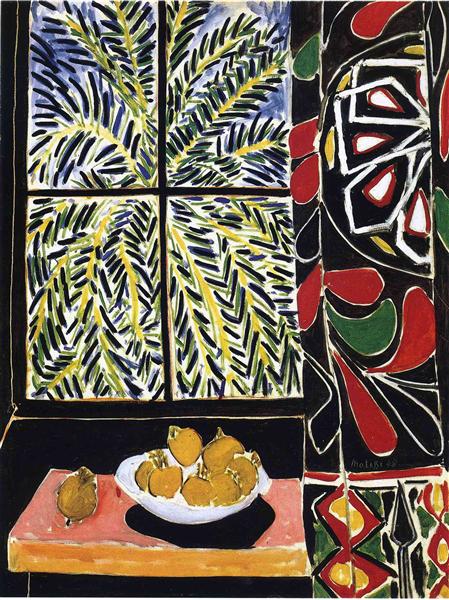Description
Among the distinctive features of late Cézanne, Henri Matisse shows, with "Interior with Egyptian Curtain", a renewed expression of boldness and sensitivity. Painted in 1948, this 45 x 60 centimeter piece encapsulates a period in Matisse's life where color and composition harmonize with such skill that it is difficult not to fall into the temptation of contemplative delight. The work presents a vivid manifestation of the elements that characterize Fauvism, the artistic movement to which Matisse contributed so significantly.
The composition of "Interior with Egyptian Curtain" is an orchestration of carefully arranged elements, endowing the scene with geometric complexity. In the foreground, the Egyptian curtain acts not only as a spatial separation but also as a central piece that introduces an exotic and dynamic universe. The curtain is not merely a decorative object; the patterns and color range evoke a sense of the ethereal and the exotic, suggesting an awareness of history and culture beyond modern Europe.
Regarding color treatment, Matisse displays his characteristic use of vibrant tones and bold contrasts. The curtain, with its fusion of vivid colors and intricate motifs, is an explosion of warm tones that contrast with the more subdued background of the interior furnishings. To the left, the burning orange of the curtain is balanced with a green rosette and underlying geometric shapes that draw a path for the viewer's eyes. This effect of transitions between colors and shapes not only provides a sense of depth but also evokes an almost dreamlike atmosphere.
If we look closely, we can discern the blurred figure of a woman sitting in the background, who seems to blur before the imposing presence of the curtain. This figure is not precisely outlined but is integrated into the composition through a soft use of tones and delicately abstract lines. This detail captures Matisse's ability to synthesize the human figure within an environment where objects take as much prominence as the characters, reinforcing the idea that in his work, the human and the inanimate coexist in perfect harmony.
The arrangement of space highlights Matisse's ability to play with perspective and depth. The table and chair, located in the center of the painting, indicate a preference for the domestic, familiar space. This homely environment is, however, imbued with an air of mystery thanks to the play of light and shadow that filter through the curtain, whose geometric stripes and bright colors open a dialogue with the patterns of the carpet and the floor.
It is interesting to note that "Interior with Egyptian Curtain" was created during an advanced stage of Matisse's career, when the artist was dealing with health problems. In this context, the work can be interpreted as a testament to the artist's ability to transform his everyday space into a stage of aesthetic and emotional exploration, even while facing his own physical limitations.
In conclusion, "Interior with Egyptian Curtain" stands as an unbreakable testament to the vision and artistic mastery of Henri Matisse. Through its intricate composition, rich color texture, and subtle inclusion of human figures, this painting not only celebrates the interior space but elevates the everyday to a dimension of contemplation and wonder. Matisse, in this work, invites us to a serene introspection, where each element shares a harmonious and vibrant dialogue.

